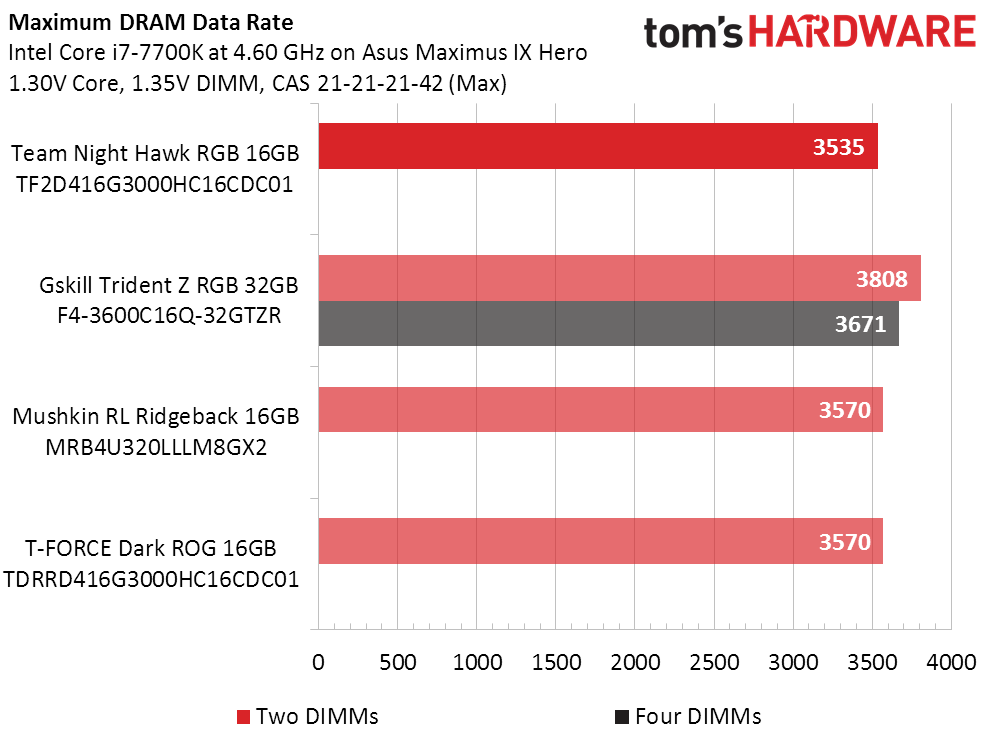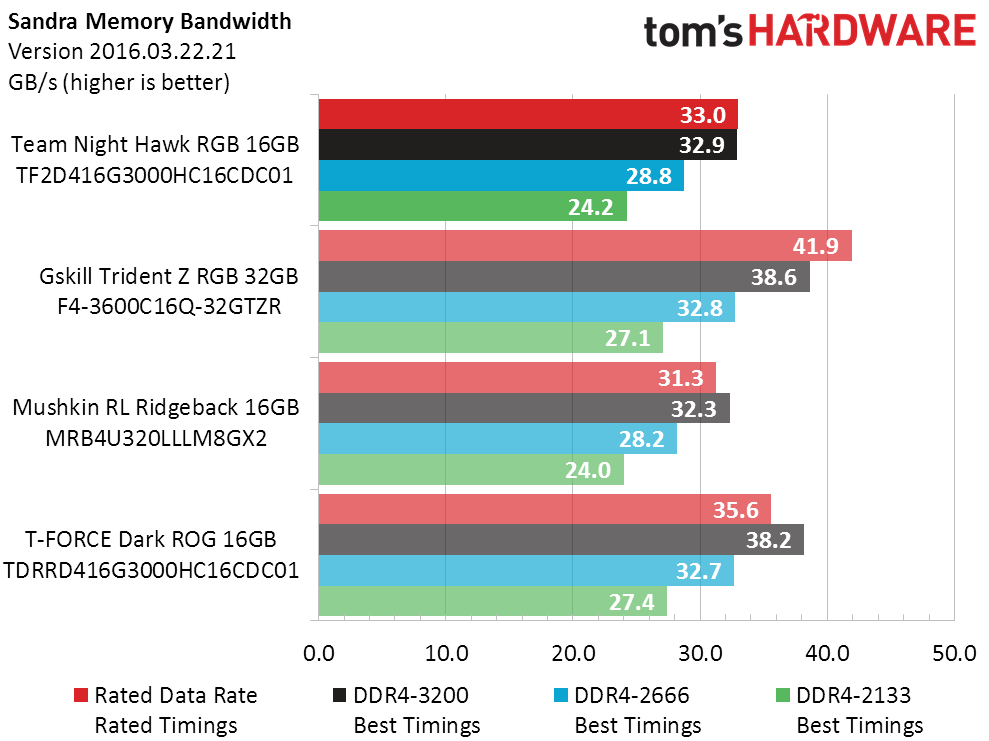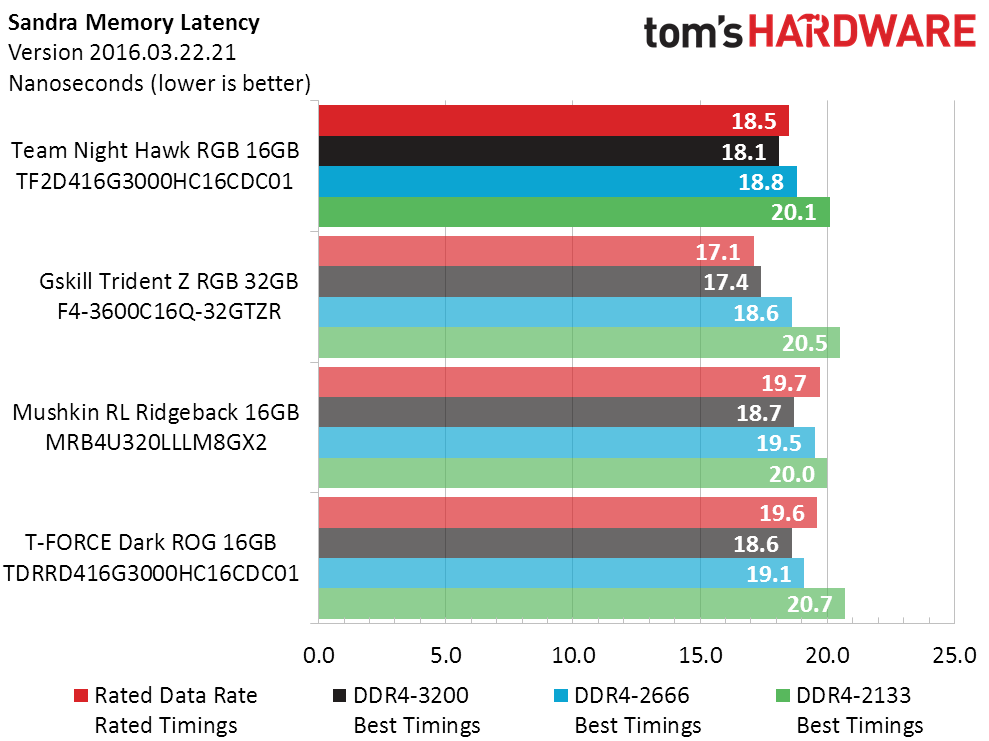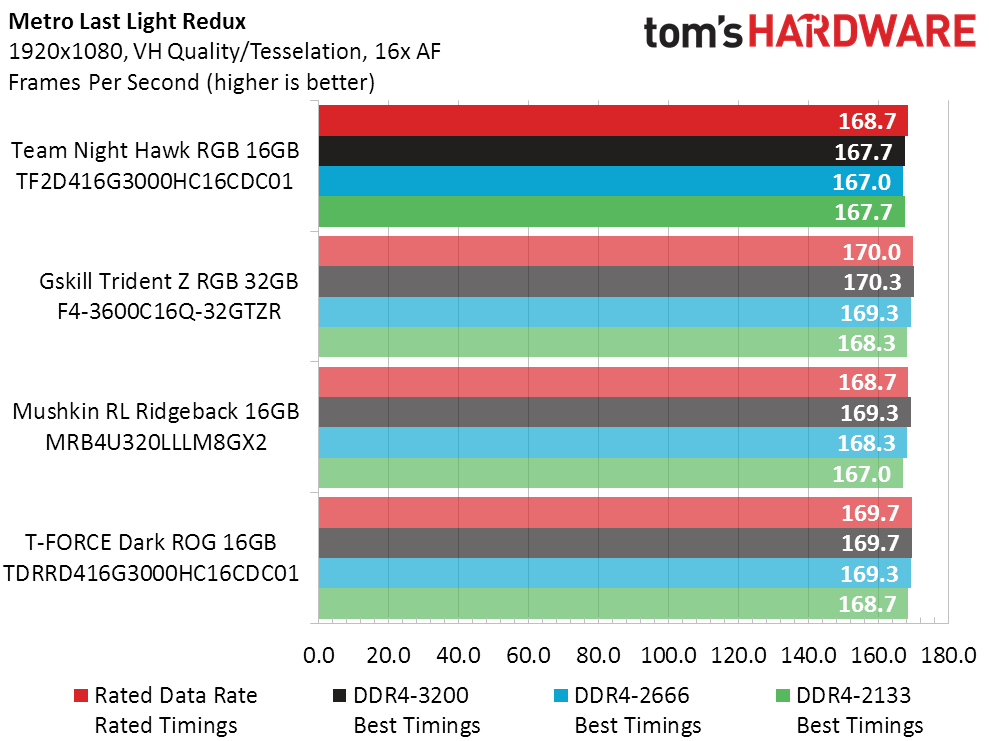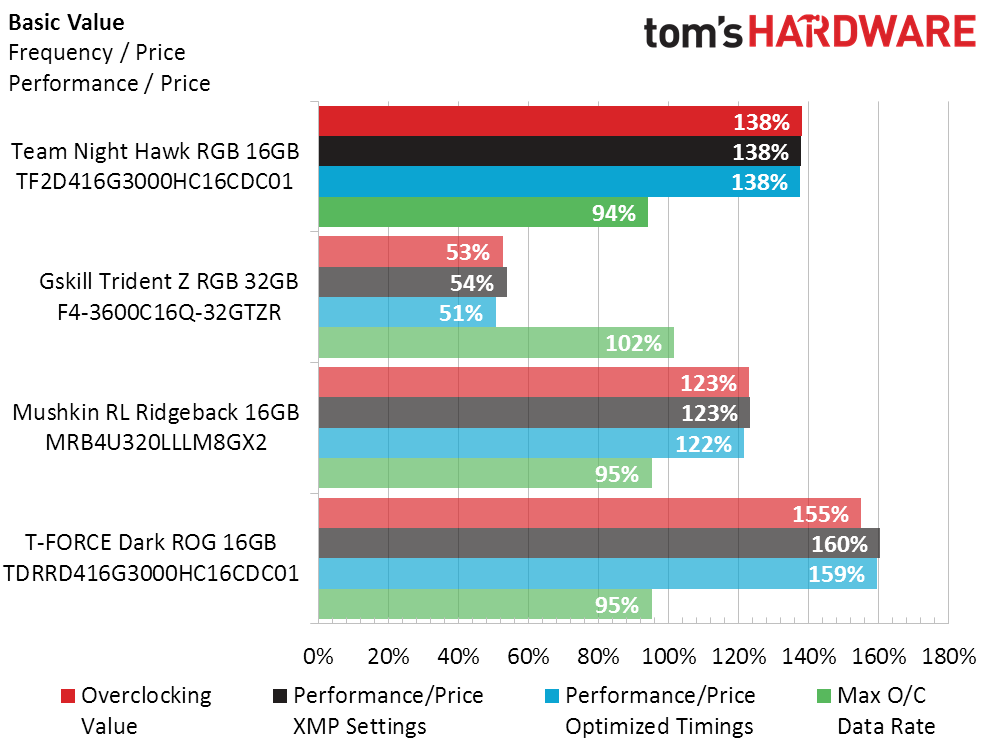Team Group Night Hawk RGB 16GB DDR4-3000 Review
Why you can trust Tom's Hardware
Benchmark Results & Final Analysis
With barely any flexibility to tighten timings, Mushkin’s Redline Ridgeback should prove a relatively easy mark for Night Hawk RGB to exceed. That still makes the new modules third-worst in tuning ability.
| Lowest Stable Timings at 1.35V (Max) on Asus Maximus IX Hero (BIOS 0801) | |||
| DDR4-3200 | DDR4-2666 | DDR4-2133 | |
| Team Night Hawk RGB 16GB TF2D416G3000HC16CDC01 | 16-18-18-36 (1T) | 13-15-15-30 (1T) | 11-12-12-28 (1T) |
| Gskill Trident Z RGB 32GB F4-3600C16Q-32GTZR | 15-16-16-32 (1T) | 12-12-12-28 (1T) | 10-11-11-28 (1T) |
| Mushkin RL Ridgeback 16GB MRB4U320LLLM8GX2 | 18-19-19-38 (1T) | 15-16-16-32 (1T) | 12-13-13-28 (1T) |
| T-FORCE Dark ROG 16GB TDRRD416G3000HC16CDC01 | 16-17-17-34 (1T) | 13-14-14-28 (1T) | 11-12-12-28 (1T) |
Night Hawk DDR4-3000 drops to fourth place in overclocking capability, though the difference between it, the Mushin DDR4-3200, and Team Group’s ROG DDR4-3000 is relatively small.
Amazingly, the Night Hawk RGB performed a little better at its rated (XMP) settings than at optimized DDR4-3200 timings. Perhaps that’s because the test motherboard de-optimized secondary and tertiary timings from a performance standpoint to provide better stability?
Lower is better in latency, and the Night Hawk RGB had the second-best latency reading at its DDR4-3200 optimized timings. That’s unusual given its mediocre bandwidth measurement, though the difference between its 18.5ns XMP setting and its 18.1ns at DDR4-3200 is relatively small.
F1 2015 is known to have memory bottlenecks, and the Night Hawk RGB’s best settings match only those of the other single-sided DIMMs in today’s test.
Metro Last Light is closer to the majority of games in that it has barely any preference for super fast RAM. It was in a race to the bottom with Mushkin’s similarly-configured DDR4-3200, and tied.
Blender also gets minimal improvement from super fast memory, though super slow RAM can do some damage. Though a single outlier score could be called a quirk, the Night Hawk RGB takes several one-second losses. On the other hand, a single-second loss would hardly be noticed in the real-life application of a three-minute render.
Get Tom's Hardware's best news and in-depth reviews, straight to your inbox.
7-Zip file compression times appear strange, though somewhat close to those of the other single-sided, dual-DIMM kit in today’s test. It appears that double-sided, or four-DIMM, is the way to go in this test.
A basic performance-per-dollar analysis hurts kits where lighting or added capacity is a big part of the pricing scheme. The Trident Z has both twice the capacity, via twice the number of DIMMs, and RGB lighting.
When we adjust the performance-per-dollar rating to capacity, we still see the Trident Z RGB flailing for any sense of reasonable value against the Night Hawk RGB. Only Team Group’s own Dark ROG is capable of overtaking the value imparted by Night Hawk RGB’s relatively-reasonable price.
Crunching a few numbers, we find that Night Hawk Dark RGB modules would need to drop $16 in price to match the performance-value of the same manufacturer’s Dark ROG kit. The question remaining is whether the RGB lighting is worth that $16. And the answer for many buyers will likely be yes. At this point, I’d like to close this review with a value award. A far higher price for G.Skill’s Trident Z obviously isn’t competing for the same market, so that makes Night Hawk RGB a top-finishing value in RGB.
Unfortunately, Team Group has already pumped the idea of optimized performance via four-rank configuration in its Dark ROG memory. You’d want two Night Hawk RGB kits to achieve both the flash and dash on a Z270 motherboard. Still, value supremacy within a very narrow set of circumstances deserves, at a minimum, our stamp of approval.
MORE: Best Memory
MORE: DDR DRAM FAQs And Troubleshooting Guide
MORE: All Memory Content
-
tingRe So this dual-channel kit runs around 3500 MB/s? Ant old Socket 1366 machine will beat that with triple channel DDR3 ECC RAM that sells for less than $2 per MB.Reply
A (vintage from 2009) Dell Precision T7500 with a second processor installed running 6 channel DDR3 will more than double that.
It's about channels, not latencies. Buy a system that supports a lot of RAM channels. Then buy a lot of cheap RAM. For the $129 you spend on 16GB of DDR4-3200 RAM, you could get 48GB (6x4GB) DDR3 ECC 1333 MHz that will double the bandwidth in the right machine.
I give up on Tom's Hardware. It's a site for people who want pretty lights, and the crooks that sell them slow, overpriced junk machines. -
JimmiG @TINGRE, those were the data rates, "clock speeds" or MT/s.Reply
At 3000 MT/s, dual channel DDR4 gives you about 38 GB/s.
With my 3200 C14 dual-channel kit and Ryzen 7, I get about 47 GB/s actual bandwidth in AIDA64 benchmark (it's higher than the 41 GB/s theoretical due to caches and pre-fetches), and a latency of about 72.5ns. Also, latency is important for many things including games.
If you just wanted lots of cheap RAM then an old workstation board with DDR3 support is a good bet, but lots of people care about IPC, clock speeds, modern instruction sets and core counts too. -
Nintendork Or maybe just buy ram at right moment for later. 1 year go you could ger 32GB of DDR4 2600-3000 CL15 for $150-170 at most.Reply -
willgart @Tingre: the latency is important when you compare the same things! if you compare a system with 1*8GB to a 2*4GB you dont compare the same things.Reply
in your example (where 6*4GB = 24GB not 48GB by the way... ;))
having 6*4GB of low latency RAMs is better than 6*4GB of high latency ones...
but I agree that we should have a pricing comparison. if you want 32GB of RAM, what's best? 2 * 16GB ? 4 * 8 ? -
Crashman Reply
We already did that.19921301 said:@Tingre: the latency is important when you compare the same things! if you compare a system with 1*8GB to a 2*4GB you dont compare the same things.
in your example (where 6*4GB = 24GB not 48GB by the way... ;))
having 6*4GB of low latency RAMs is better than 6*4GB of high latency ones...
but I agree that we should have a pricing comparison. if you want 32GB of RAM, what's best? 2 * 16GB ? 4 * 8 ?
http://www.tomshardware.com/reviews/super-talent-project-x-f3000ux16g-ddr4-memory,5038.htmlYou want at least four banks.
If you don't know how that applies to your question, maybe you should read the article :D
Only in a very dark room :D19921312 said:mmm... does the LED supports the black color? ;-)
